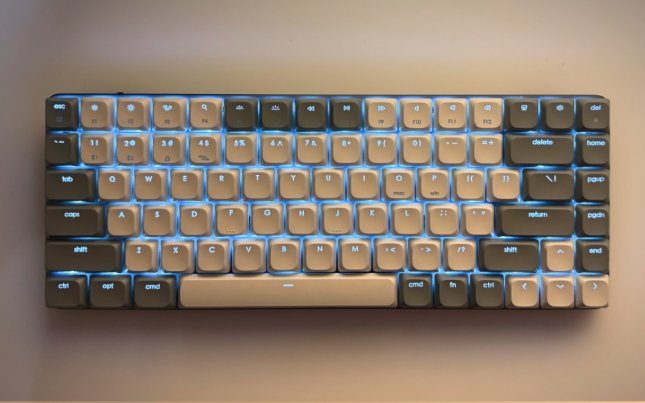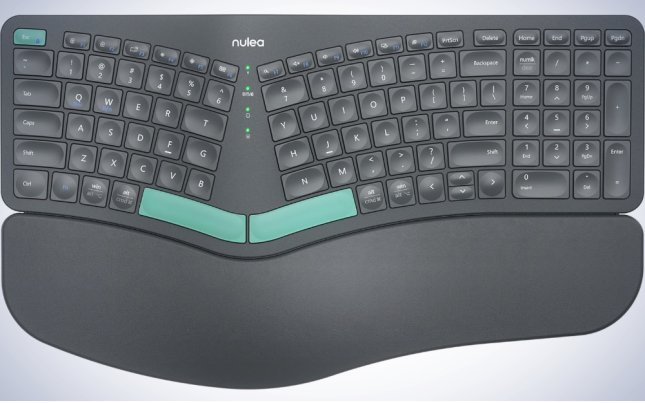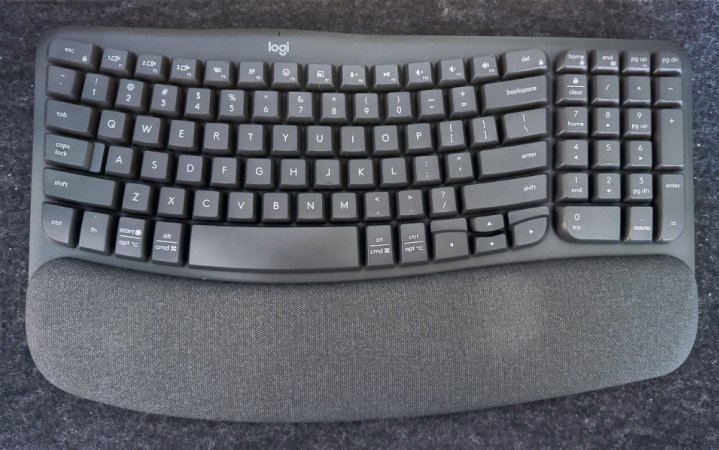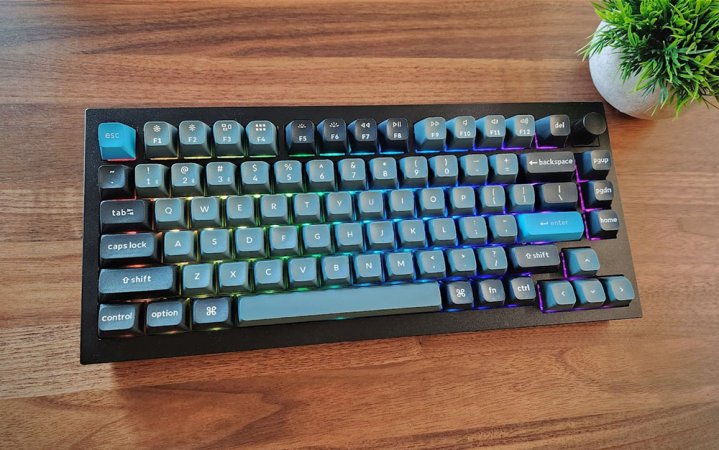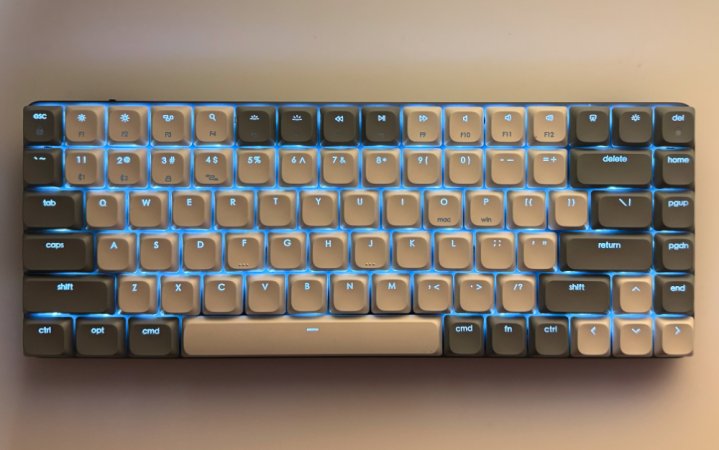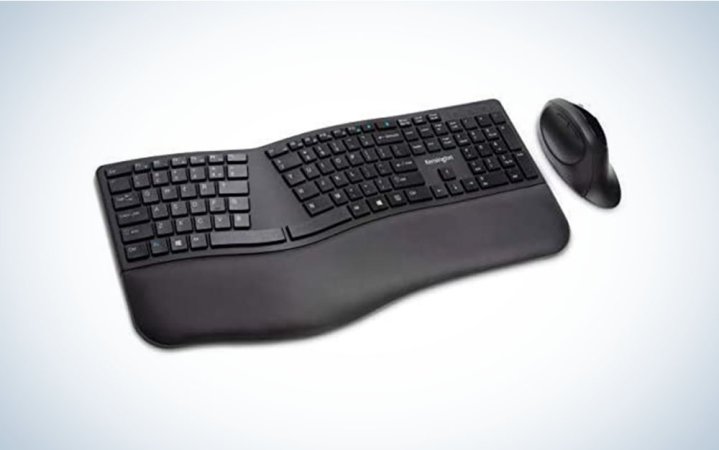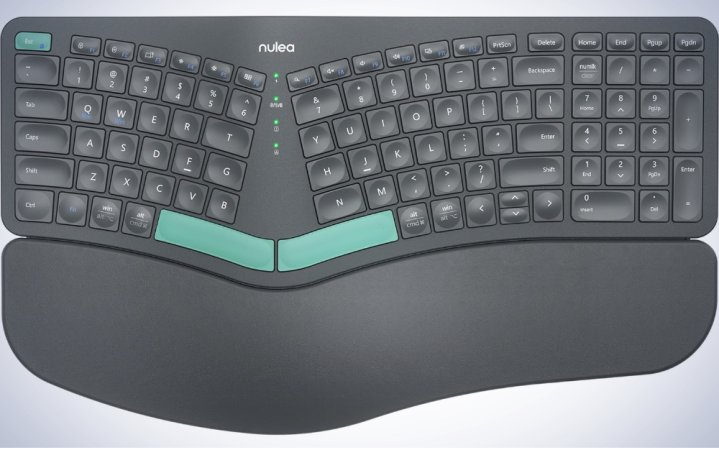We may earn revenue from the products available on this page and participate in affiliate programs. Learn more ›
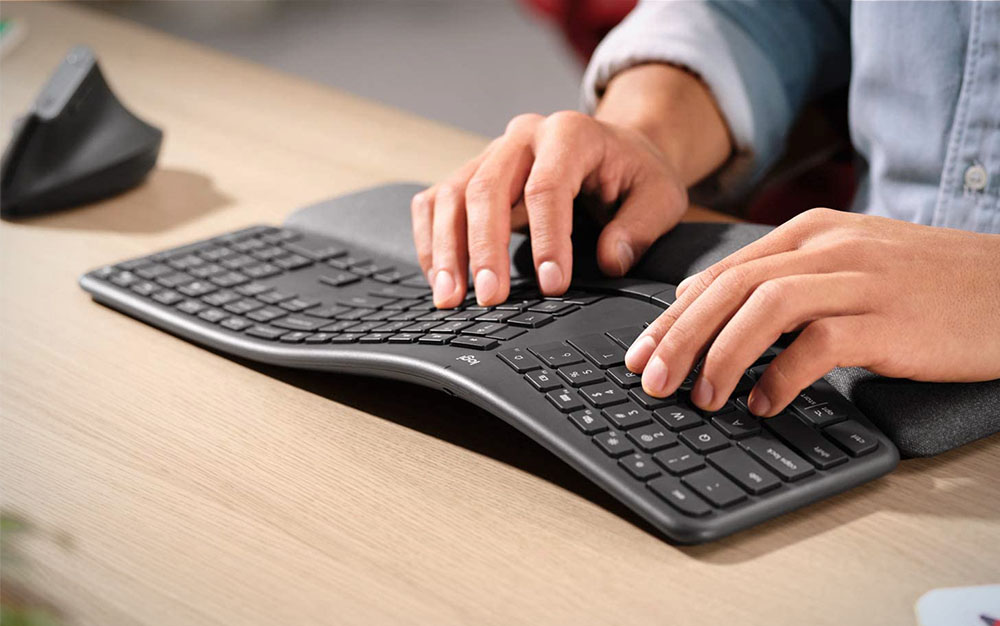
If you’ve been spending an increasing amount of time at your desk, you may have noticed added discomfort from all that typing, a situation that could be remedied by switching to a more ergonomic keyboard. When you spend a lot of time sitting down, working at a computer, it’s easy to forget about posture or what angle your wrists should be at. The best ergonomic keyboards will help reduce your odds of suffering from conditions like RSI (Repetitive Strain Injury) while making typing a little more fun.
- Best overall: Logitech Wave Keys
- Best splurge: Keychron Q1 Pro
- Best compact: Satechi SM1
- Best bundle: Kensington Pro Ergonomic Keyboard and Mouse
- Best budget: Nulea RT05B
How we chose the best ergonomic keyboards
If you’re looking for the best ergonomic keyboard, first consider your space and how you plan on using it. If you typically use a laptop, how will a keyboard change your flow? Do you want to reduce the look of burdensome wires? Are you typing, accounting, or gaming? Our top picks are based on these and other considerations (more of which you’ll find below the recommendations). Combined with ergonomic desks, ergonomic chairs, and an ergonomic mouse, they can make sitting at a desk all day a lot more comfortable.
The best ergonomic keyboards: Reviews & Recommendations
Whether you’re typing for work or gaming with friends, the best ergonomic keyboards can help you focus on the task at hand—instead of what the task is doing to your hands. However, with so many options, it might be difficult to figure out exactly which product is ideal for your situation. This is especially true since many of the best ergonomic options look entirely different—or exactly the same. We’ve done the research and testing for you, so if you’re ready to make your workspace more comfortable, check out the best ergonomic keyboards below.
Best overall: Logitech Wave Keys
Designed for Comfort
Pros
- Compatible with Windows and macOS
- Can connect via a USB receiver or Bluetooth
- Built-in wrist rest
Cons
- Wrist support can’t be removed
- No backlit keys
Specs
- Connectivity: USB receiver, Bluetooth
- Dimensions: 9.17 x 17.95 x 1.89 inches
- Weight: 2.15 pounds
The ergonomically sound Logitech Wave Keys keyboard was made to keep your hands in a natural typing posture. Its namesake feature is a gentle slope that begins raising at the D key and declining to the L key. You’d think a topographically diverse keyboard would be more difficult to type on, but our tests proved it was very comfortable to use. We experienced no wrist pain after several weeks of switching from a flatter keyboard. The Wave Key’s wristrest is a big reason for this comfort, as it ensures your wrists are kept on a padded surface at the proper elevation. However, the wristrest is physically attached to the keyboard and non-removable, so you’ll need a deep desk to contain it.
We prefer this ergonomic keyboard design to those with two separate sets of keys and a large gap between them because the Wave Keys had no learning curve. We instinctively knew where the keys would be and could focus on what we were typing. This Logitech wireless ergonomic keyboard is fully compatible with macOS and Windows and allows you to connect it to your machine using a USB receiver or Bluetooth. We conducted our tests on a MacBook Pro using both the receiver and Bluetooth and never had an issue with connectivity or lag while typing. We wish the Wave Keys featured a couple more premium features—the biggest being backlit keys—but that disappointment is far outweighed by the feeling of comfortably typing away without the risk of wrist strain. And you can pair the keyboard with an equally recommendable Logitech mouse that matches it in form and function.
Best splurge: Keychron Q1 Pro
Best overall
Keychron Q1 Pro
Pros
- Premium feeling aluminum case
- Smooth durable switches with colorful keycaps
- Highly programmable on both macOS and Windows
Cons
- Tall keycaps come with a learning curve
- Not travel friendly
Specs
- Connectivity: Bluetooth, wired
- Dimensions: 12.89 x 5.71 x 1.41 inches
- Weight: 3.83 pounds
We named the Keychron Q1 Pro the best mechanical keyboard in large part because of the ergonomic qualities possessed by mechanical keyboards. This is the professional version of Keychron’s already excellent Q1, and it bests the previous model in every way. It carries through all the features we loved about the original, including its heavy-duty and exceptionally premium-feeling aluminum case, but critically adds support for Bluetooth wireless connectivity. Aluminum cases tend to block wireless signals, but the Q1 offers a reliable and fast Bluetooth connection, which allows us to cut the cord without sacrificing typing performance. We don’t recommend traveling with it, however: This keyboard is hefty at just under four pounds.
The addition of Bluetooth isn’t the only improvement that comes with the Q1 Pro. Keychron reworked its internals so the keyboard can deliver both the softest typing experience yet and satisfyingly supple acoustics. The switches are pre-lubed for extra smoothness, and a brand new set of doubleshot PBT keycaps add a splash of color and heightened durability. The only downside is that these keys are slightly taller than average keycaps and it may take an hour or so to adapt to them. The Q1 Pro isn’t cheap, but it still feels like a steal once you’ve put your fingers to it.
Best compact: Satechi SM1
Best budget
Satechi SM1
Pros
- Fits easily on any desktop
- Backlit keys
- MacOS function keys
Cons
- Slightly lower profile frame
Specs
- Connectivity: Bluetooth, USB adapter
- Size: 12.2 x 4.69 x 0.83 inches
- Weight: 1.04 pounds
If you’re interested in improving the ergonomics of your computer setup but don’t have a large enough desk to accommodate the Logitech Wave or similarly sized models, we highly recommend Satechi’s SM1. In our tests, which included writing dozens of articles, e-mails, and notes, the SM1 dropped no keystrokes. its switches were immediately responsive and compressed with a satisfying click. Those sensitive to noise may want a quieter keyboard, but the SM1 is far from deafening. You’ll know what to expect if you remember typing on computer keys in the 1990s. Satechi allows you to wirelessly connect this keyboard to your computer via Bluetooth or a USB dongle—we generally chose the latter—or to plug it into your machine using a USB-C cable. The SM1 has a built-in rechargeable battery, so you don’t have to worry about reaching for a set of AAAs when the keyboard runs out of juice.
Each individual key on the SM1 is backlit and you can raise and lower their brightness by pressing the F5 and F6 keys, respectively. There are three brightness levels so that you can make adjustments as the lighting in your environment changes. This is especially helpful if you work in a room with a variable amount of sunshine or a single dim light source. Speaking of function keys, macOS users will appreciate that the SM1 has an identical function row to the one found on Apple’s MacBook Pro and Magic Keyboard. This means you can control your computer’s volume and screen brightness with a single keystroke. Key macOS features, including Spotlight and Control Center, are also accessible by pressing dedicated keys.
Our only ergonomic complaint with the SM1 is that it has a relatively low profile even when its feet are extended. It’s not that the keyboard is uncomfortable to use, but we recommend using a wrist rest. If you’re looking for an ergonomic keyboard for travel or use on a slimmer desk, look no further.
Best bundle: Kensington Pro Ergonomic Keyboard and Mouse
A Powerful Duo
Pros
- A sloped design keeps your hands positioned inward
- Designed to work with Chrome OS in addition to macOS and Windows
- A helpful bundle that can save you money
Cons
- Runs on disposable batteries
Specs
- Connectivity: Bluetooth, USB receiver
- Dimensions: 18.98 x 9.92 x 1.5 inches
- Weight: 2.2 pounds
You can pick up an ergonomic keyboard and mouse on their own, but Kensington’s bundle allows you to nab both accessories for under $100. The keyboard features a sloped design, with spill-proof keys that won’t get damaged when exposed to water. Kensington says the keys are designed to be quiet, too, so you’ll give up the clickiness of a mechanical keyboard for less noise. You can connect both of these accessories to your computer using a USB receiver or Bluetooth.
Kensington says both wireless connectivity options include “government-grade encryption” to keep your keystrokes secure. Additionally, Kensington is explicit that this keyboard supports macOS, Windows, and Chrome OS. While we’re recommending this bundle primarily for the included keyboard, it’s worth noting that the included mouse has five programmable buttons, allowing you to customize your computing experience when connected. Switching over your tech accessories to more ergonomic models can be a pain, but Kensington’s bundle will help you check off two of the most important ones in a single click.
Best budget: Nulea RT05B
Nulea RT05B
Pros
- Quiet keys
- Connects via USB receiver or Bluetooth
- Built-in wrist rest with memory foam
Cons
- Wrist support cannot be removed
- Keys not backlit
Specs
- Connectivity: USB receiver, Bluetooth
- Dimensions: 17.52 x 10.87 x 1.73 inches
- Weight: 3.85 pounds
Nulea’s RT05B shares many of the same features as our top pick, from a built-in wristrest to multiple connectivity options, but it’s available for just $50. The ergonomic split keyboard has a wave-like design with an elevated space between both banks of keys. The keyboard is attached to a polyurethane leather-wrapped wristrest featuring a layer of memory foam. The rest elevates your wrists at a 4.07-degree angle when the keyboard’s legs are extended to keep them slightly above the keyboard itself. You can’t remove the wrist rest, so you can only use the RT05B on a deeper desk.
This isn’t a mechanical keyboard, which means you’ll give up some key travel but be rewarded with a quieter typing experience. You can connect it to your computer (either running macOS or Windows) using Bluetooth or a 2.4GHz USB receiver and top up its internal battery by plugging it into your PC. The RT05B doesn’t have backlit keys or any other special features, but that’s to be expected from a keyboard in its price range. Instead, Nulea has managed to make ergonomics more accessible to significantly more people, which is a big deal if you’re looking to improve your computing setup on a budget.
What to consider when shopping for the best ergonomic keyboards
There are many factors to consider when deciding which ergonomic keyboard is right for you. The following are the factors we considered most important when writing this guide:
Price
With elevated design, in-depth research, and smart innovation, many keyboards can get pretty expensive, with costs averaging a few hundred dollars. If your goal is simply working more comfortably, that price may not feel justifiable. Fortunately, some cheap keyboards will do the job without breaking the bank. Choosing a product from a reliable manufacturer will likely give you a better, more comfortable experience than ones that may look ergonomic but simply don’t maximize your comfort on a functional level.
Quietness
If you’re looking for the best keyboard for typing, you’ll want to consider the shape of the keyboard and the environment where you’ll use it. Since ergonomic products support your body as you use them, keyboards designed particularly for typing will be shaped to fit your natural hand posture as you type. But as you’re clacking away on the keys, you might be sensitive to how loud you’re typing (especially if you don’t work alone). A quiet ergonomic model is the best of both worlds: You won’t disturb your officemates, but you’ll still get the wrist and hand support you need for a pain-free typing session.
Connectivity
The best ergonomic keyboard for you might be one that reduces visual clutter. Many keyboards—ergonomic or not—connect to your computer through extra wires, and it only takes a few devices to turn a completely bare desk into a jungle of tangled wire vines. An ergonomic wireless model allows you to get the comfort you need without any extra cords, thanks to Bluetooth connectivity.
Additional features
If you’re looking for the best ergonomic gaming option, look for all the typical things you’d want in any gaming keyboard. You’ll want it to be a comfortable size, to be able to move between your mouse and your keys quickly. It’s also likely that you’ll want something mechanical to maximize the feedback you feel every time you click. RGB lights, in addition to adding a cool look, can also add some functionality if the keyboard has per-key color options that allow you to quickly glance at what keys you’d like to select without a second thought. When it comes to ergonomics, you’ll want your keyboard to meet your hands where they’ll naturally want to lay. Take into consideration the other devices in your gaming setup. If the keyboard is awkward, it may interfere with the ideal placement of your mic and other consoles.
Bundles
If this is your first keyboard purchase or if you’re building up your workspace from scratch, you may need more than just an ergonomic keyboard—your desktop space likely also needs a mouse to go with it. Finding an ergonomic keyboard and mouse combo not only looks cleaner on your desk but will also likely feel better to work with, as the designers of the products created them to go together and provide you with equal ergonomic support whether you’re typing or clicking.
FAQs
Ergonomic keyboards really help to relieve pain and tension from the physical act of typing. In comparison to traditional keyboards, the goal of an ergonomic keyboard is to allow one to type while naturally maintaining proper body and hand posture. If you’ve never used an ergonomic keyboard and haven’t noticed any bodily discomfort from typing, you may not notice an immediate difference when you start using your new keyboard; however, you will certainly notice an increase in discomfort after you return to your regular keyboard, as you will now be more aware of the added irritation in your body. Regardless of what keyboard you’re using, if you experience consistent pain in your wrists or hands when you type, consult a medical professional.
When choosing one, think about how you’re planning to use it. Since ergonomics are designed for more comfortable and natural use, keyboards designed for different uses, like typing vs gaming, may look and feel different. The goal is to choose the best ergonomic keyboard for what you’re going to be doing the most so that you can enhance your experience and your comfort.
These keyboards might seem like they are expensive for their materials, but the real cost exists because of the design and development required to create them. After all, you’re looking for an ergonomic experience, which means that researchers put in more time and careful consideration to craft a device that provides the maximum level of comfort and efficiency.
Final thoughts on the best ergonomic keyboards
- Best overall: Logitech Wave Keys
- Best splurge: Keychron Q1 Pro
- Best compact: Satechi SM1
- Best bundle: Kensington Pro Ergonomic Keyboard and Mouse
- Best budget: Nulea RT05B
There are plenty of good keyboards out there, whether you’ll be gaming, working from home, or typing away in a shared office space. While you may not need all the bells and whistles, you need one that truly supports good posture and hand placement. No matter which product you choose, the best ergonomic keyboard for you will be one that’s built for your needs. Once you’re all set up, then you can really get down to business.

